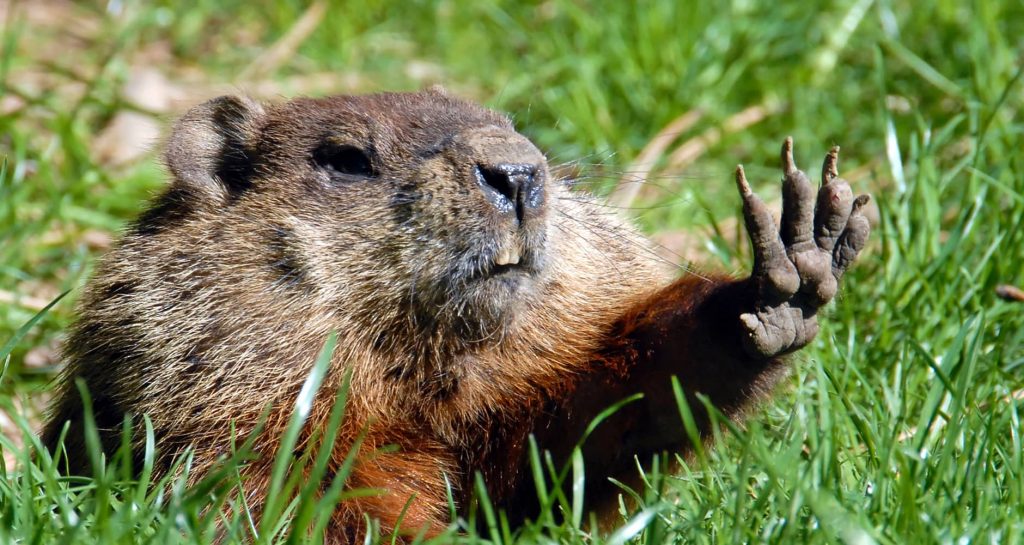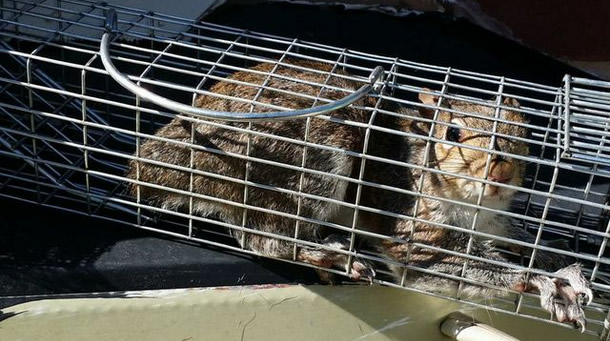Spring and summer season brings flowers, outdoor activities, and the very destructive yard rodent: the groundhog. A larger member of the squirrel family, the Marmota monax can wreak havoc to homes, yards, and foundations. Many homeowners have experienced the destruction caused by groundhogs -and their elusive behavior. While most groundhogs are pretty shy and getting rid of them is challenging, it’s not impossible. Follow these steps to safely and humanely get rid of groundhogs on your property.

During the winter, groundhogs go into deep hibernation, which means that they are confined to their burrows and do not move. Because of this, groundhog control efforts will only be successful in the spring and summer.
Groundhogs are best dealt with early in the spring, before mating season, when they are less likely to return. It’s nearly impossible to keep a groundhog from reproducing once she’s in the gestation stage. In addition, you’ll have to deal with additional groundhogs on your property if a female gives birth.
Find out what the rules are for capturing and relocating groundhogs and woodchucks in your area before setting up a live trap! When in doubt, call a wildlife removal specialist to assist in removing nuisance groundhogs.
How to Remove Groundhogs from Your Yard (Humanely)
Trapping, repelling and excluding are the most effective methods for getting rid of groundhogs, also known as woodchucks. The first line of defense for many homeowners is to remove the food sources that draw groundhogs. Trapping comes in second. Wickenkamp, Safeguard and Tomahawk traps are our go-to choice when it comes to trapping.

Eliminate Groundhog Attractants
If you have food sources and a safe place to burrow in your yard, groundhogs will come to investigate. There are a few things you can do to minimize damage and make your property less appealing, starting with eliminating food sources. Veggies, peas, and melons should be harvested as soon as possible in the garden.
Removing debris, rocks, and woodpiles that groundhogs might use as a cover is a good idea if you want to keep them out of your yard.
Groundhogs may eat or hide out in these plants, so keep them under control.
Make sure there are no tree trunks or other wood sources for groundhogs to gnaw. Use gravel to fill in any unused animal burrows in your yard.
Target Your Groundhog Control Methods
Finding out how and where your groundhog spends most of its time will help you select an effective method of groundhog control. The following are typical groundhog antics:
- Eating and damaging peas, beans, flowers, melons and alfalfa
- Consuming clover and other grasses
- Digging holes and burrowing under lawns and structures
Locate the entrances and exits of any groundhog burrows that may exist on your property. Typically, a burrow has 2-5 entrance holes, each measuring 6-8 inches in width. Groundhogs frequently conceal their burrows by digging them deep into the ground and then covering them with a loose layer of vegetation or even sticks and leaves to disguise their presence.
Choosing the Best Groundhog Control Method
Controlling your groundhog is much easier once you know where it is located and what damage it is causing. In order to get rid of groundhogs and keep them from invading your property, you should try a variety of methods.
Live Groundhog Traps
A live groundhog trap is the best way to get rid of a groundhog. You should be aware of the following things when dealing with a groundhog.
- Wear gloves when handling the trap to avoid contaminating it with your scent.
- It’s important to bait your trap in such a way as to force the groundhog to completely enter the trap, so it can’t get back out when the door closes.
- Ensure that the trap cannot move in order to prevent the groundhog from rolling over and escaping. Extra support can be added by placing a brick on top.
- Use leaves to camouflage the trap’s interior and exterior so the groundhog will feel more at ease entering.
Repellents for Groundhogs
A groundhog’s heightened sense of smell and taste will be aggravated by a pepper-based repellent. If you use one all over your yard, you can keep groundhogs out, stop them from chewing on plants and surfaces, and prevent destructive digging and burrowing.
Types of Repellants for Groundhogs
- Granular Repellents – The best way to keep groundhogs away from problem areas is to use a granular repellent.
- Liquid Repellents – If you’re concerned about a pet gnawing or digging into your garden’s foliage, spray the surface with a liquid repellent to keep them away. Repellants rarely work to keep a mother groundhog away from her young, which is an important point to remember. Before you try to exterminate a groundhog, you may want to check to see if there is a nest nearby.
- Electronic deterrents – Use bursts of water to scare away groundhogs with highly effective electronic repellents. This will condition them to stay away from any area. In order to keep groundhogs away from your property, you should consider using electronic devices instead of traditional liquid and granular repellents. It is virtually maintenance-free to use motion-activated water sprinklers to protect your home or business in areas such as: Lawns and yards, mulch beds, vegetable gardens, plants, pathways, flowerbeds, pool areas, pond areas, garden structures, entryways, garbage cans, and trees.
- Fencing – A well-built fence can make it more difficult for groundhogs to enter your yard. For best effectiveness, fences should follow these guidelines
- The height of the fence should be at least three to four feet above the surrounding ground.
- Use a 3″ x 3″ wire fence with no more than 3″ x 3″ openings.
- To keep groundhogs from burrowing beneath the fence, it should be at least one foot deep. Creating a “L” shape in the ground is the best way to go.
- Add an outward angle to the top of the fence to make it more difficult to climb over.
Groundhog burrows can cause serious structural damage if they are not properly controlled. It is common for their tunnels to demolish building foundations, and they are known to gnaw through electrical wires and irrigation systems. Use multiple groundhog control products at once for the best results.
Groundhogs are more likely to live on your property or burrow under the grass or foundation if there are plants, woodpiles, and other debris around your home. This destructive behavior can be prevented by reducing ground cover.
Protect abandoned burrows from groundhogs by enclosing them with wire fencing. When you’re done, cover the hole with 3 feet by 3 feet of wire fencing and bury it in the ground. Verify that the burrow does not contain any groundhogs.
Got a groundhog problem? Give us a call or contact us today!

